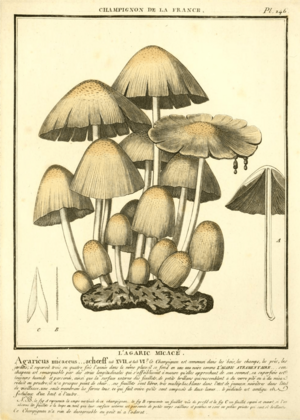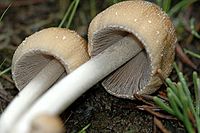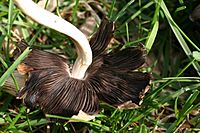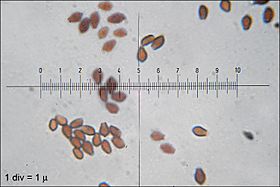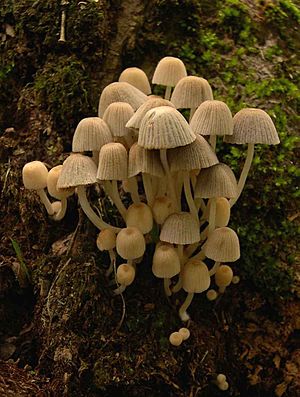Mica cap facts for kids
Quick facts for kids Mica cap |
|
|---|---|
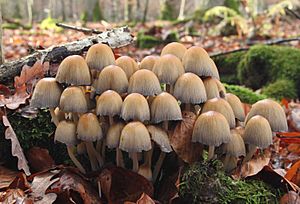 |
|
| Mushrooms near Erbach an der Donau, Germany | |
| Scientific classification | |
| Synonyms | |
|
| Coprinellus micaceus | |
|---|---|
| Mycological characteristics | |
| gills on hymenium | |
| cap is conical or campanulate | |
| hymenium is adnexed | |
| stipe is bare | |
| spore print is black | |
| ecology is saprotrophic | |
| edibility: edible | |
Coprinellus micaceus is a very common type of mushroom found all over the world. It's a fungus that grows in clusters on or near rotting hardwood tree stumps or underground tree roots. This mushroom is known by several fun names like mica cap, shiny cap, and glistening inky cap. These names come from the tiny, shiny, mica-like bits that cover the cap when the mushroom is young.
The caps of these mushrooms are usually a tawny-brown color. They can change shape as they grow, from oval to bell-shaped, and can be up to 3 centimeters (about 1.2 inches) wide. The caps have fine lines or grooves that go almost to the center. They sit on whitish stems (called stipes) that can be up to 10 centimeters (about 4 inches) long. Even though the mushrooms are small and have thin flesh, you often find many of them growing together in dense groups.
A few hours after you pick them, the gills under the cap will start to slowly turn into a black, inky liquid. This process is called autodigestion or deliquescence, and it's how the mushroom releases its spores. You can eat these mushrooms, but only before the gills turn black and dissolve. Cooking them will stop this dissolving process.
Scientists have studied C. micaceus a lot, especially its tiny parts and how its cells divide. It's often used as a model organism to learn about cell division and meiosis in fungi. Researchers have also found chemicals in these mushrooms that can fight bacteria and stop certain enzymes. This mushroom used to be called Coprinus micaceus, but in 2001, scientists moved it to a new group called Coprinellus after studying its family tree. It looks very much like another mushroom called Coprinellus truncorum, so it can be hard to tell them apart without a microscope.
Contents
History and How It Got Its Name
The Coprinellus micaceus mushroom was first drawn in a woodcut by a botanist named Carolus Clusius way back in the 1500s. He included it in his book about rare plants in 1601. However, Clusius mistakenly thought this mushroom was poisonous.
The first scientific description of the species was made by French botanist Jean Baptiste François Pierre Bulliard in 1786. He called it Agaricus micaceus. Later, in 1801, Christian Hendrik Persoon grouped all gilled fungi that dissolved themselves (like this one) into a section called Coprinus. Then, Elias Magnus Fries made Coprinus a full genus, and the mushroom became known as Coprinus micaceus.
In the 1990s, new studies showed that many mushrooms that looked like Coprinus were not actually closely related. Because of this, in 2001, the genus Coprinus was split into four new groups, and C. micaceus was moved to the genus Coprinellus.
Because they are easy to find and grow in labs, C. micaceus and similar mushrooms were often used in cell studies in the 1800s and 1900s. Early scientists like Johann Heinrich Friedrich Link and Arthur Henry Reginald Buller studied how these mushrooms produce and release their spores.
The name micaceus comes from the Latin word mica, which means "crumb" or "grain of salt." It also relates to the word micare, meaning "to glitter." This is why the mushroom is commonly called the "shiny cap," "mica cap," or "glistening inky cap." All these names refer to the tiny, shiny particles on the cap that look like mica. In Malayalam, a language spoken in India, it's called Ari koon, which means 'rice mushroom'.
What It Looks Like
The cap of Coprinellus micaceus starts out oval or cylinder-shaped, about 1 to 2.5 centimeters (0.4 to 1 inch) wide. As it grows, it becomes bell-shaped, sometimes with a small bump in the middle. Finally, it flattens out a bit, becoming convex. When fully open, the cap can be up to 5 centimeters (2 inches) wide, and its edges might tear into rays that turn slightly upward.
The cap is usually yellow-brown or tan, often darker in the center. The edges become pale yellow or buff. The cap has clear grooves that go almost to the center. These grooves show where the longer gills are underneath. When the mushroom is young, its cap is covered with white or whitish shiny particles. These are leftover bits from a protective layer that covered the young mushroom. These particles are loose and can wash off easily, so older mushrooms often look smooth. Coprinellus micaceus is also hygrophanous, which means its color changes depending on how much water it has absorbed.
The gills are packed closely together and are narrowly attached to the stem. They start out white, then turn dark brown, and finally black as the spores ripen. As the cap expands, the gills split open, tearing the cap's edge. The process of releasing spores and dissolving starts at the bottom of the gills before the top parts turn completely black.
The stem is hollow and brittle. It's about 3 to 10 centimeters (1.2 to 4 inches) long and 2 to 5 millimeters (0.08 to 0.2 inches) thick, and it's usually the same thickness all the way down. It's generally white but might turn a pale, dirty cream color from the bottom up. The stem surface starts out velvety with a fine whitish powder, but this wears off, making it smooth. Sometimes, there's a small ring at the base of the stem, which is another leftover piece of the protective layer. The spore print (the color of the spores left behind) is dark brown or black. The mushroom's flesh is thin, fragile, white in the stem, and brownish in the cap. It doesn't have a strong smell or taste. It takes about five to seven days for an individual mushroom to fully grow.
Microscopic Details
The spores of C. micaceus are reddish-brown or black. They are tiny, measuring about 7–10 by 4.5–6 µm. They are usually shaped like a lens (lentiform), but from the side, they look more like an almond or spindle. From the front, they look oval or like a shield (mitriform). Spores have a germ pore, which is a flat spot where a germ tube can grow out.
The cells that produce spores, called basidia, are club-shaped and have four spores each. They measure 10–15 by 4–7 µm. Scientists have found that these basidia grow in four different stages, with some sticking out more than others. This staggered growth helps the spores get released without bumping into each other.
There are also special cells called Cystidia on the mushroom. Those on the cap's edge (cheilocystidia) are round. Those on the gill faces (pleurocystidia) are club-shaped or elongated. These pleurocystidia stick out from the gill surface and act like guards. They stop the gills from touching each other, making sure there's enough space for the basidia and spores to grow properly.
The shiny, round cells that make the cap look like mica are colorless and smooth. They are about 25–65 µm in size. Scientist Arthur Buller explained that their "glitter" is simply light hitting them and bouncing off, just like light reflects off tiny water drops on grass in the morning.
In 1914, Michael Levine was the first to successfully grow C. micaceus from spores in a lab. The mushrooms grew in about 40 to 60 days. This mushroom is useful for studying how cells divide because its chromosomes are easy to see under a microscope. C. micaceus has 12 chromosomes.
Edibility
Coprinellus micaceus is an edible species. Cooking stops the enzymes that cause the mushroom to dissolve, which can start as soon as an hour after picking. It's considered good for omelets and sauces, but its flavor is very delicate and can be easily hidden by other ingredients.
A study on the minerals in different edible mushrooms found that C. micaceus has the most potassium—almost half a gram of potassium per kilogram of mushroom! However, these mushrooms can also absorb harmful heavy metals like lead and cadmium. So, it's best not to eat too many mushrooms picked from roadsides or other places that might have pollution.
Similar Species
There are several mushrooms that look similar to Coprinellus micaceus:
- The edible Coprinellus bisporus looks almost the same but doesn't have the yellowish cap granules and only has two spores per basidium instead of four.
- The scaly inky cap (Coprinus variegatus) has a grayish-brown cap with dull white to brownish scales and an unpleasant smell.
- The trooping crumble cap (Coprinellus disseminatus, also edible) has smaller, yellow-brown to grey-brown caps. Its white gills turn black but don't dissolve. It always grows in large clusters on rotting wood.
- Coprinopsis atramentaria is a larger, gray mushroom that grows in dense clusters. It doesn't have the shiny particles on its cap, and its cap and gills dissolve when mature.
- Coprinellus radians grows alone or in clumps on wood, often from a fuzzy mat of yellow-orange mycelium.
- Coprinellus truncorum is very hard to tell apart from C. micaceus just by looking at it. You usually need a microscope to see the difference in their spore shapes. Some studies suggest C. micaceus has a browner cap center and grows in larger clusters than C. truncorum.
- Coprinellus flocculosus is another similar species.
Where It Lives and Grows
Coprinellus micaceus is a saprotrophic species, which means it gets its food from dead and decaying organic matter. It grows on and around stumps or logs of broad-leaved trees, or on wood buried underground. It especially likes to feed on the bark of trees. This mushroom is a "late stage colonizer," meaning it prefers wood that has already started to break down and become soft.
A study in 2010 suggested that this fungus can also live inside healthy trees without causing them harm. You can often find C. micaceus in disturbed areas like roadsides, gardens, construction sites, and parking lot edges. It has even been found growing indoors on rotting wood in humid places, and once, about 120 meters (400 feet) underground in an old coal mine, growing on wooden supports.
These mushrooms are commonly found growing in dense clusters, but you can also find them alone or in small groups, especially in forests. In North America, C. micaceus is one of the first edible mushrooms to appear in spring, fruiting from April to September. In Europe, it fruits from May to December. While it can grow any time of year, it's most common in spring and fall when there's more humidity and rain. This species is known for growing back in the same spot year after year. In one case, over 17 kilograms (38 pounds) of fresh mushrooms were collected from one elm stump in 10 harvests during a single spring and summer!
Coprinellus micaceus is found all over the world. It has been collected in northern Africa, South Africa, Europe (including Turkey), North America (even Alaska), the Hawaiian islands, South America, India, Australia, New Zealand, and Japan.
Special Chemicals It Makes
Scientists have studied the chemicals found in Coprinellus micaceus and discovered some unique compounds.
- Micaceol is a type of sterol that has some ability to fight bacteria like Corynebacterium xerosis and Staphylococcus aureus.
- Another compound, (Z,Z)-4-oxo-2,5-heptadienedioic acid, can stop an enzyme called glutathione S-transferase. This enzyme is sometimes involved in how cancer cells resist cancer treatments.
- In 1962, researchers also found a chemical called tryptamine in C. micaceus, though they didn't say how much was present.
- The mushrooms also produce different pigments called melanins. These complex chemicals help form humus in the soil after the mushrooms break down.
See also
In Spanish: Coprino micáceo para niños


